Effectiveness of Cool and Green Roofs Inside and Outside Buildings in the Brazilian Context
Abstract
1. Introduction
2. Materials and Methods
2.1. Case Studies
2.1.1. Building Model
2.1.2. Climatic Contexts
2.1.3. Roof Typologies
2.2. Computer Simulation
2.2.1. Energy Consumption for Air-Conditioning
2.2.2. Thermal Comfort
2.2.3. Outside Surface Temperature
2.3. Results Analysis
3. Results and Discussions
3.1. Energy Consumption for Air-Conditioning
3.2. Thermal Comfort
3.3. Outside Surface Temperature
3.4. Summary of Results
3.5. Recommendations for Urban Planning Policies and Building Regulations in Brazil
4. Conclusions
- -
- Cool roofs are recommended to reduce energy consumption in cities with a warmer climate, such as Florianópolis and Brasília (electricity consumption can be reduced by up to 24.8% compared with the traditional roof). Green roofs showed better energy performance in Curitiba, a city with lower average annual temperatures, reducing energy consumption by 28.2% compared with the traditional roof.
- -
- Green roofs resulted in the highest percentages of thermal comfort hours in all climates (between 57.3% and 82.2% in the living room and between 69.8% and 96.3% in the bedrooms, depending on the climatic context).
- -
- Cool and green roofs can reduce the outside surface temperature compared with the traditional roof. Considering hourly temperatures, the cool roof can reduce the temperature by up to 16.5 °C, and the green roof by up to 28.4 °C, compared with the traditional roof.
- -
- Depending on the roof typology and the climate, thermal insulation can increase or decrease electricity consumption (variation between −10.6% and 20.6%) and the percentage of thermal comfort hours (variation between −13.7 and 8.0 percentage points). The outside surface temperature of traditional and cool roofs increased with thermal insulation, and that of the green roof was not affected. Therefore, from the perspective of the outside environment, thermal insulation is not recommended.
Supplementary Materials
Author Contributions
Funding
Data Availability Statement
Conflicts of Interest
References
- IEA. World Energy Outlook 2023; IEA: Paris, France, 2023. [Google Scholar]
- EPE. Balanço energético nacional. In Ano Base 2022; EPE: Brasília, Brasil, 2023. (In Portuguese) [Google Scholar]
- Santamouris, M.; Synnefa, A.; Karlessi, T. Using advanced cool materials in the urban built environment to mitigate heat islands and improve thermal comfort conditions. Sol. Energy 2011, 85, 3085–3102. [Google Scholar]
- Piselli, C.; Saffari, M.; de Gracia, A.; Pisello, A.L.; Cotana, F.; Cabeza, L.F. Optimization of roof solar reflectance under different climate conditions, occupancy, building configuration and energy systems. Energy Build. 2017, 151, 81–97. [Google Scholar] [CrossRef]
- Besir, A.B.; Cuce, E. Green roofs and facades: A comprehensive review. Renew. Sustain. Energy Rev. 2018, 82, 915–939. [Google Scholar] [CrossRef]
- Alim, M.A.; Rahman, A.; Tao, Z.; Garner, B.; Griffith, R.; Liebman, M. Green roof as an effective tool for sustainable urban development: An Australian perspective in relation to stormwater and building energy management. J. Clean. Prod. 2022, 362, 132561. [Google Scholar]
- Hernández-Pérez, I.; Álvarez, G.; Xamán, J.; Zavala-Guillén, I.; Arce, J.; Simá, E. Thermal performance of reflective materials applied to exterior building components—A review. Energy Build. 2014, 80, 81–105. [Google Scholar] [CrossRef]
- Silva, C.M.; Gomes, M.G.; Silva, M. Green roofs energy performance in Mediterranean climate. Energy Build. 2016, 116, 318–325. [Google Scholar] [CrossRef]
- Vera, S.; Pinto, C.; Tabares-Velasco, P.C.; Bustamante, W.; Victorero, F.; Gironás, J.; Bonilla, C.A. Influence of vegetation, substrate, and thermal insulation of an extensive vegetated roof on the thermal performance of retail stores in semiarid and marine climates. Energy Build. 2017, 146, 312–321. [Google Scholar] [CrossRef]
- Zhu, Z.; Wang, W.; Chen, B.; Cai, Z.; Chang, M.; Wang, X. The canopy cooling effect of roof mitigation strategies in a subtropical urban agglomeration. Urban Clim. 2024, 55, 101977. [Google Scholar] [CrossRef]
- Sultana, R.; Ahmed, Z.; Hossain, M.A.; Begum, B.A. Impact of green roof on human comfort level and carbon sequestration: A microclimatic and comparative assessment in Dhaka City, Bangladesh. Urban Clim. 2021, 38, 100878. [Google Scholar] [CrossRef]
- Cirrincione, L.; Marvuglia, A.; Scaccianoce, G. Assessing the effectiveness of green roofs in enhancing the energy and indoor comfort resilience of urban buildings to climate change: Methodology proposal and application. Build. Environ. 2021, 205, 108198. [Google Scholar] [CrossRef]
- Gagliano, A.; Detommaso, M.; Nocera, F.; Evola, G. A multi-criteria methodology for comparing the energy and environmental behavior of cool, green and traditional roofs. Build. Environ. 2015, 90, 71–81. [Google Scholar] [CrossRef]
- Bevilacqua, P. The effectiveness of green roofs in reducing building energy consumptions across different climates. A summary of literature results. Renew. Sustain. Energy Rev. 2021, 151, 111523. [Google Scholar] [CrossRef]
- Mihalakakou, G.; Souliotis, M.; Papadaki, M.; Menounou, P.; Dimopoulos, P.; Kolokotsa, D.; Paravantis, J.A.; Tsangrassoulis, A.; Panaras, G.; Giannakopoulos, E.; et al. Green roofs as a nature-based solution for improving urban sustainability: Progress and perspectives. Renew. Sustain. Energy Rev. 2023, 180, 113306. [Google Scholar]
- Ouldboukhitine, S.E.; Bakkour, A.; Amziane, S.; Belarbi, R. A comparative study of energy performance of Green, White, and gravel roofs in a temperate climate through In-Situ measurement and dynamic simulation. Energy Build. 2024, 320, 114630. [Google Scholar] [CrossRef]
- He, Y.; Yu, H.; Ozaki, A.; Dong, N. Thermal and energy performance of green roof and cool roof: A comparison study in Shanghai area. J. Clean. Prod. 2020, 267, 122205. [Google Scholar] [CrossRef]
- Rawat, M.; Singh, R.N. A study on the comparative review of cool roof thermal performance in various regions. Energy Built Environ. 2022, 3, 327–347. [Google Scholar]
- IBGE. Censo 2022. Available online: https://censo2022.ibge.gov.br/panorama/ (accessed on 29 November 2023).
- Vijayaraghavan, K. Green roofs: A critical review on the role of components, benefits, limitations and trends. Renew. Sustain. Energy Rev. 2016, 57, 740–752. [Google Scholar] [CrossRef]
- Balvedi, N.; Giglio, T. Influence of green roof systems on the energy performance of buildings and their surroundings. J. Build. Eng. 2023, 70, 106430. [Google Scholar] [CrossRef]
- Dias, A.E. O Desempenho Térmico de uma Cobertura Verde em Simulações Computacionais em Três Cidades Brasileiras. Master’s Thesis, Postgraduate Programme in Civil Engineering at the Federal University of Santa Catarina, Florianópolis, Brazil, 2016. (In Portuguese). [Google Scholar]
- Tonietto, T.L. Telhado Verde e Telhado frio e suas Contribuições para a Redução da Temperatura Ambiente em Construções na Cidade de Cascavel no Oeste do Estado do Paraná. Master’s Thesis, Postgraduate Programme in Civil Engineering, Federal University of Santa Catarina, State University of Western Paraná, Cascavel, Brazil, 2021. (In Portuguese). [Google Scholar]
- Sailor, D.J.; Elley, T.B.; Gibson, M. Exploring the building energy impacts of green roof design decisions-a modeling study of buildings in four distinct climates. J. Build. Phys. 2012, 35, 372–391. [Google Scholar] [CrossRef]
- Silva, A.L.G.; Etulain, C.R. Avaliação do Impacto Econômico da Proibição do Uso do Amianto na Construção Civil no Brasil; Universidade Estadual de Campinas: Campinas, Brazil, 2010; 36p. (In Portuguese) [Google Scholar]
- Krelling, A.F.; Eli, L.G.; Olinger, M.S.; Machado, R.M.E.S.; Melo, A.P.; Lamberts, R. A thermal performance standard for residential buildings in warm climates: Lessons learned in Brazil. Energy Build. 2023, 281, 112770. [Google Scholar] [CrossRef]
- Mendes, V.F.; Cruz, A.S.; Gomes, A.P.; Mendes, J.C. A systematic review of methods for evaluating the thermal performance of buildings through energy simulations. Renew. Sustain. Energy Rev. 2024, 189, 113875. [Google Scholar] [CrossRef]
- Lamberts, R.; Ghisi, E.; Pereira, C.D.; Batista, J.O. Casa Eficiente: Simulação Computacional do Desempenho Termo-Energético; UFSC/LabEEE: Florianópolis, Brazil, 2010. (In Portuguese) [Google Scholar]
- Triana, M.A.; Lamberts, R.; Sassi, P. Characterisation of representative building typologies for social housing projects in Brazil and its energy performance. Energy Policy 2015, 87, 524–541. [Google Scholar] [CrossRef]
- Pisello, A.L.; Piselli, C.; Cotana, F. Influence of human behavior on cool roof effect for summer cooling. Build. Environ. 2015, 88, 116–128. [Google Scholar] [CrossRef]
- Cascone, S.; Catania, F.; Gagliano, A.; Sciuto, G. A comprehensive study on green roof performance for retrofitting existing buildings. Build. Environ. 2018, 136, 227–239. [Google Scholar] [CrossRef]
- Crawley, D.; Lawrie, L. Repository of Free Climate Data for Building Performance Simulation. Available online: https://climate.onebuilding.org/ (accessed on 23 January 2024).
- Alvares, C.A.; Stape, J.L.; Sentelhas, P.C.; de Moraes Gonçalves, J.L.; Sparovek, G. Köppen’s climate classification map for Brazil. Meteorol. Z. 2013, 22, 711–728. [Google Scholar] [CrossRef]
- ABNT NBR 15220-3; Desempenho Térmico de Edificações. Parte 3: Zoneamento Bioclimático Brasileiro E Diretrizes Constru-Tivas para Habitações Unifamiliares de Interesse Social. Associação Brasileira de Normas Técnicas (ABNT): Rio de Janeiro, Brazil, 2005. (In Portuguese)
- Sailor, D.J. A green roof model for building energy simulation programs. Energy Build. 2008, 40, 1466–1478. [Google Scholar] [CrossRef]
- Castleton, H.F.; Stovin, V.; Beck, S.B.M.; Davison, J.B. Green roofs; building energy savings and the potential for retrofit. Energy Build. 2010, 42, 1582–1591. [Google Scholar] [CrossRef]
- Gagliano, A.; Detommaso, M.; Nocera, F.; Berardi, U. The adoption of green roofs for the retrofitting of existing buildings in the Mediterranean climate. Int. J. Sustain. Build. Technol. Urban Dev. 2016, 7, 116–129. [Google Scholar] [CrossRef]
- Wark, C.G.; WARK, W.W. Green roof specifications and standards-Establishing an emerging technology. Constr. Specifier. 2003, 56, 76–82. [Google Scholar]
- Scolaro, T.P.; Ghisi, E. Life cycle assessment of green roofs: A literature review of layers materials and purposes. Sci. Total Environ. 2022, 829, 154650. [Google Scholar] [CrossRef]
- Koroxenidis, E.; Theodosiou, T. Comparative environmental and economic evaluation of green roofs under Mediterranean climate conditions—Extensive green roofs a potentially preferable solution. J. Clean. Prod. 2021, 311, 127563. [Google Scholar] [CrossRef]
- Chenani, S.B.; Lehvävirta, S.; Häkkinen, T. Life cycle assessment of layers of green roofs. J. Clean. Prod. 2015, 90, 153–162. [Google Scholar] [CrossRef]
- ABNT NBR 16401-2; Instalações de Ar-Condicionado—Sistemas Centrais e Unitários. Parte 2: Parâmetros de Conforto Térmico. Associação Brasileira de Normas Técnicas (ABNT): Rio de Janeiro, Brazil, 2008. (In Portuguese)
- ABNT NBR 15575-1; Edificações Habitacionais—Desempenho. Parte 1: Requisitos Gerais. Associação Brasileira de Normas Técnicas (ABNT): Rio de Janeiro, Brazil, 2021. (In Portuguese)
- INMETRO. Anexo II da Portaria INMETRO No 309/2022. Instrução Normativa Inmetro para a Eficiência Energética das Edificações Residenciais. 2022. Available online: http://sistema-sil.inmetro.gov.br/rtac/RTAC002989.pdf (accessed on 4 May 2023). (In Portuguese)
- INMETRO. Portaria no 234 de 29 de Junho de 2022. 2022. Available online: https://www.gov.br/inmetro/pt-br/centrais-de-conteudo/publicacoes/portaria-234-29-de-junho-de-2020.pdf (accessed on 4 May 2023). (In Portuguese)
- ASHRAE Standard 55; Thermal Environmental Conditions for Human Occupancy. ASHRAE: Atlanta, GA, USA, 2020.
- Costanzo, V.; Evola, G.; Marletta, L. Energy savings in buildings or UHI mitigation? Comparison between green roofs and cool roofs. Energy Build. 2016, 114, 247–255. [Google Scholar] [CrossRef]
- He, Y.; Yu, H.; Dong, N.; Ye, H. Thermal and energy performance assessment of extensive green roof in summer: A case study of a lightweight building in Shanghai. Energy Build. 2016, 127, 762–773. [Google Scholar] [CrossRef]
- Huang, Y.Y.; Chen, C.T.; Liu, W.T. Thermal performance of extensive green roofs in a subtropical metropolitan area. Energy Build. 2018, 159, 39–53. [Google Scholar] [CrossRef]
- Borràs, J.G.; Lerma, C.; Mas, Á.; Vercher, J.; Gil, E. Energy Efficiency Evaluation of Green Roofs as an Intervention Strategy in Residential Buildings in the Field of Spanish Climate. Buildings 2022, 12, 959. [Google Scholar] [CrossRef]
- Synnefa, A.; Santamouris, M.; Akbari, H. Estimating the effect of using cool coatings on energy loads and thermal comfort in residential buildings in various climatic conditions. Energy Build. 2007, 39, 1167–1174. [Google Scholar] [CrossRef]
- Guo, R.; Gao, Y.; Zhuang, C.; Heiselberg, P.; Levinson, R.; Zhao, X.; Shi, D. Optimization of cool roof and night ventilation in office buildings: A case study in Xiamen, China. Renew. Energy 2020, 147, 2279–2294. [Google Scholar] [CrossRef]
- Tang, M.; Zheng, X. Experimental study of the thermal performance of an extensive green roof on sunny summer days. Appl. Energy 2019, 242, 1010–1021. [Google Scholar] [CrossRef]
- Guattari, C.; Evangelisti, L.; Asdrubali, F.; De Lieto Vollaro, R.L. Experimental evaluation and numerical simulation of the thermal performance of a green roof. Appl. Sci. 2020, 10, 1767. [Google Scholar] [CrossRef]
- Brazil Bases para a Atualização Colaborativa da Agenda Nacional de Desenvolvimento Urbano Sustentável; Apoio à Agenda Nacional de Desenvolvimento Urbano Sustentável no Brasil (ANDUS): Brasília, Brazil, 2021. (In Portuguese)
- IEA. Energy System of Brazil; IEA: Paris, France, 2024. [Google Scholar]
- João Pessoa. Lei nº 12.467, de 25 de janeiro de 2013. Dispõe sobre contratação por tempo determinado para atender a necessidade temporária de excepcional interesse público, nos termos do inciso IX, do art. 37 da constituição federal. João Pessoa: Câmara Municipal. 2003. (In Portuguese)
- Guarulhos. Lei nº 7031, de 17 de abril de 2012. Dispõe sobre a instalação do “telhado verde” nos locais que especifica, e dá outras providências. 2012. (In Portuguese)
- Recife. Lei nº 18.112/2015. Dispõe sobre a melhoria da qualidade ambiental das edificações por meio da obrigatoriedade de instalação do “telhado verde”, e construção de reservatórios de acúmulo ou de retardo do escoamento das águas pluviais para a rede de drenagem e dá outras providências. 2015. (In Portuguese)
- Rio de Janeiro. Decreto nº 35745 de 06 de junho de 2012. Cria a qualificação qualiverde e estabelece critérios para sua obtenção. 2012. (In Portuguese)
- Santos. Lei complementar nº 913, de 21 de dezembro de 2015. Concede incentivo fiscal à implantação de “coberturas verdes” nos edifícios do município, e dá outras providências. 2015. (In Portuguese)
- European Union. Directive (EU) 2024/1275 of the European Parliament and of the Council of 24 April 2024 on the Energy Performance of Buildings (Recast) (Text with EEA Relevance); European Union: Dublin, Ireland, 2024. [Google Scholar]

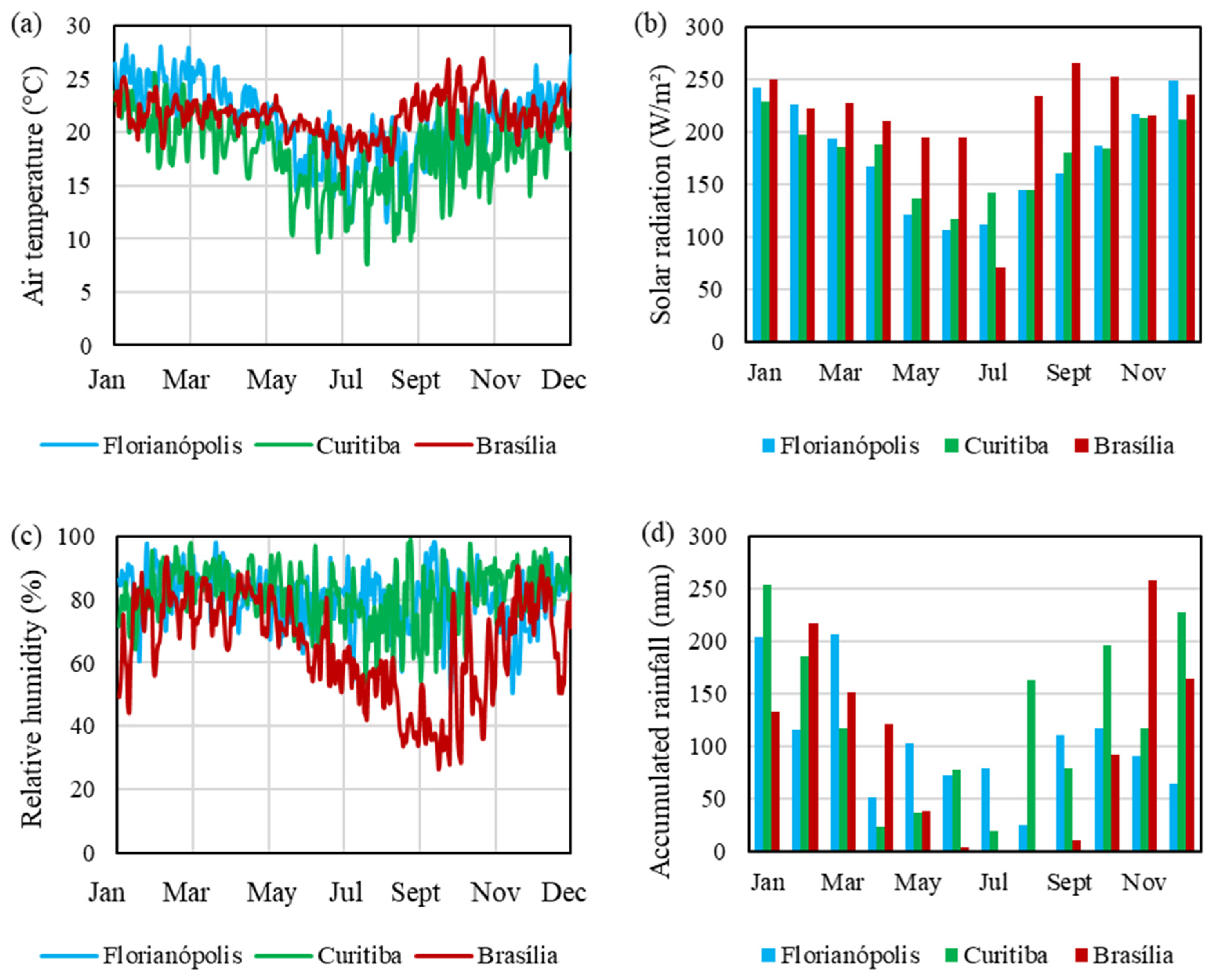
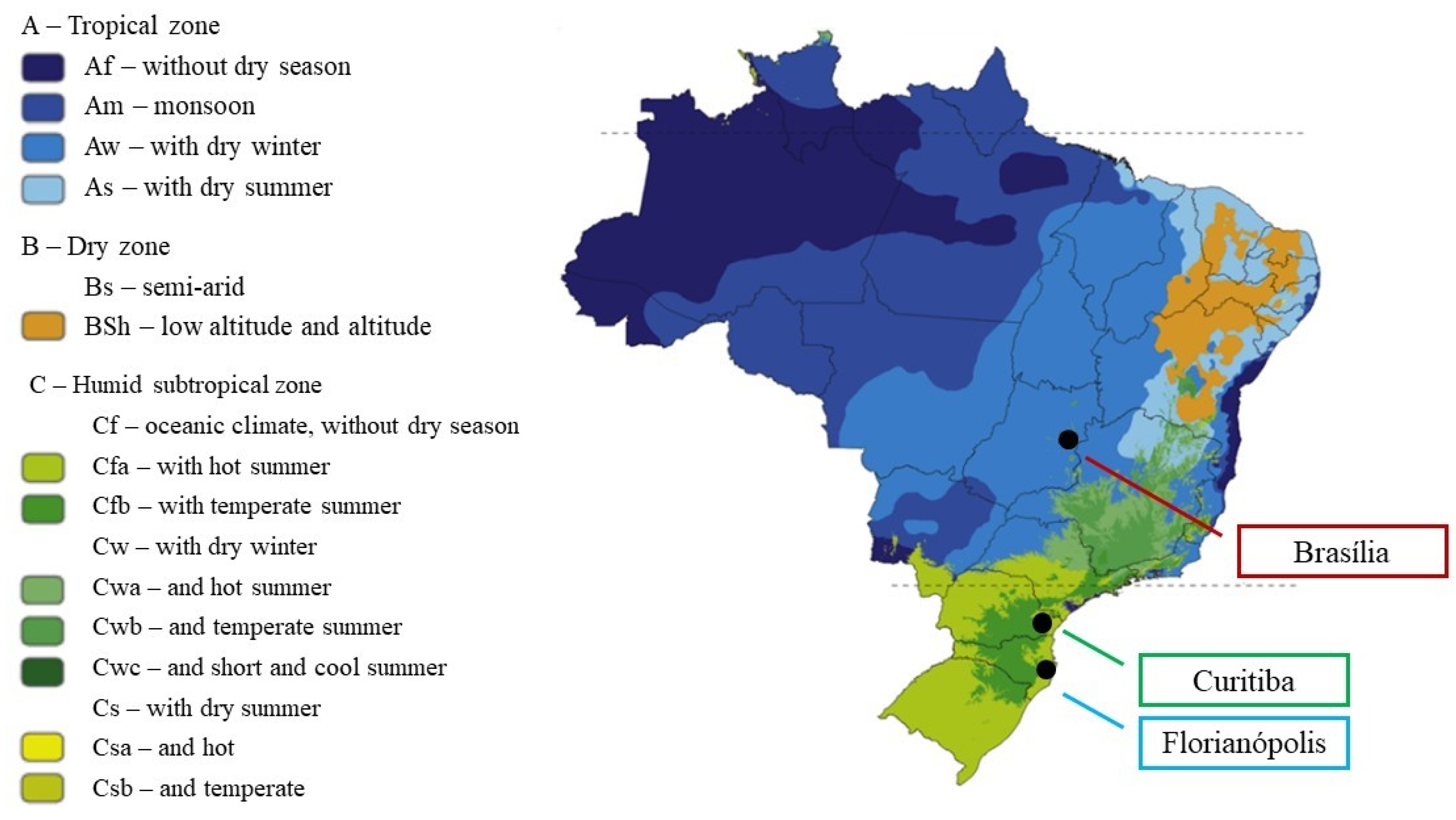
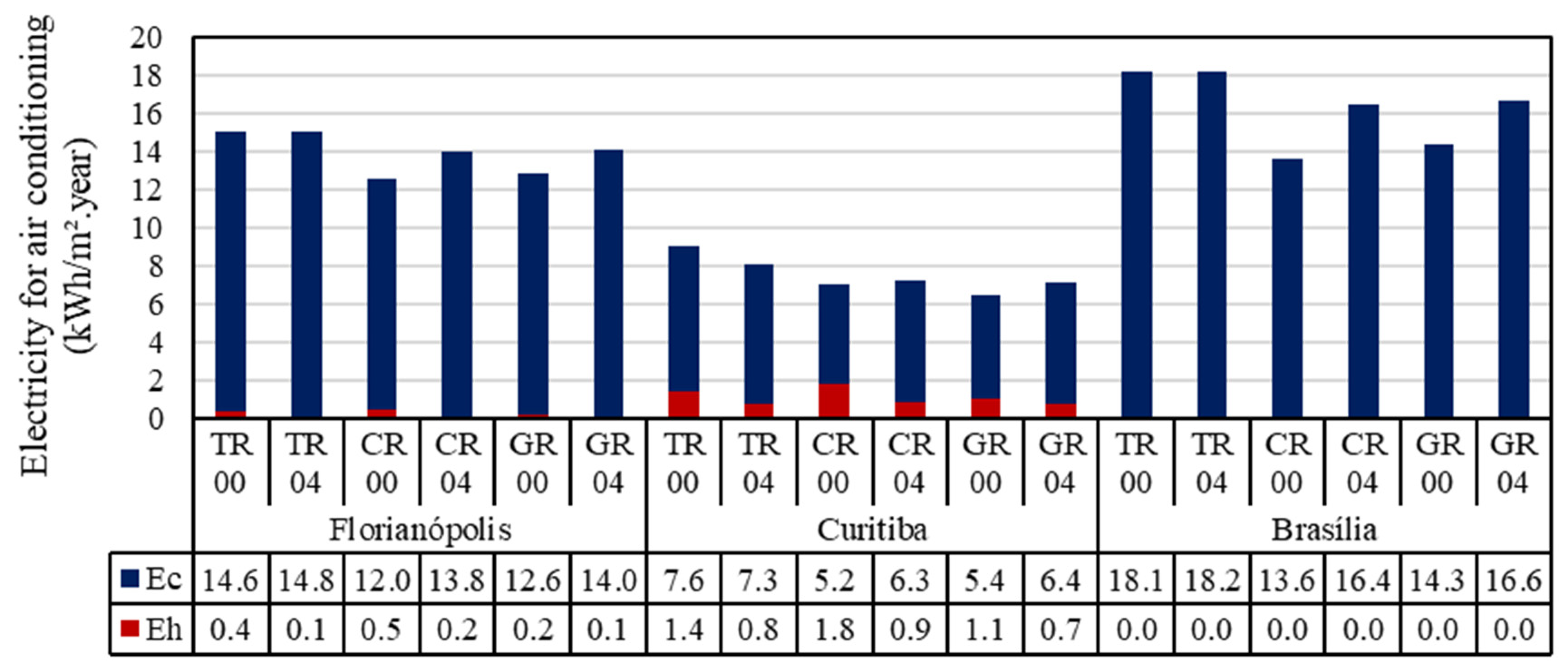
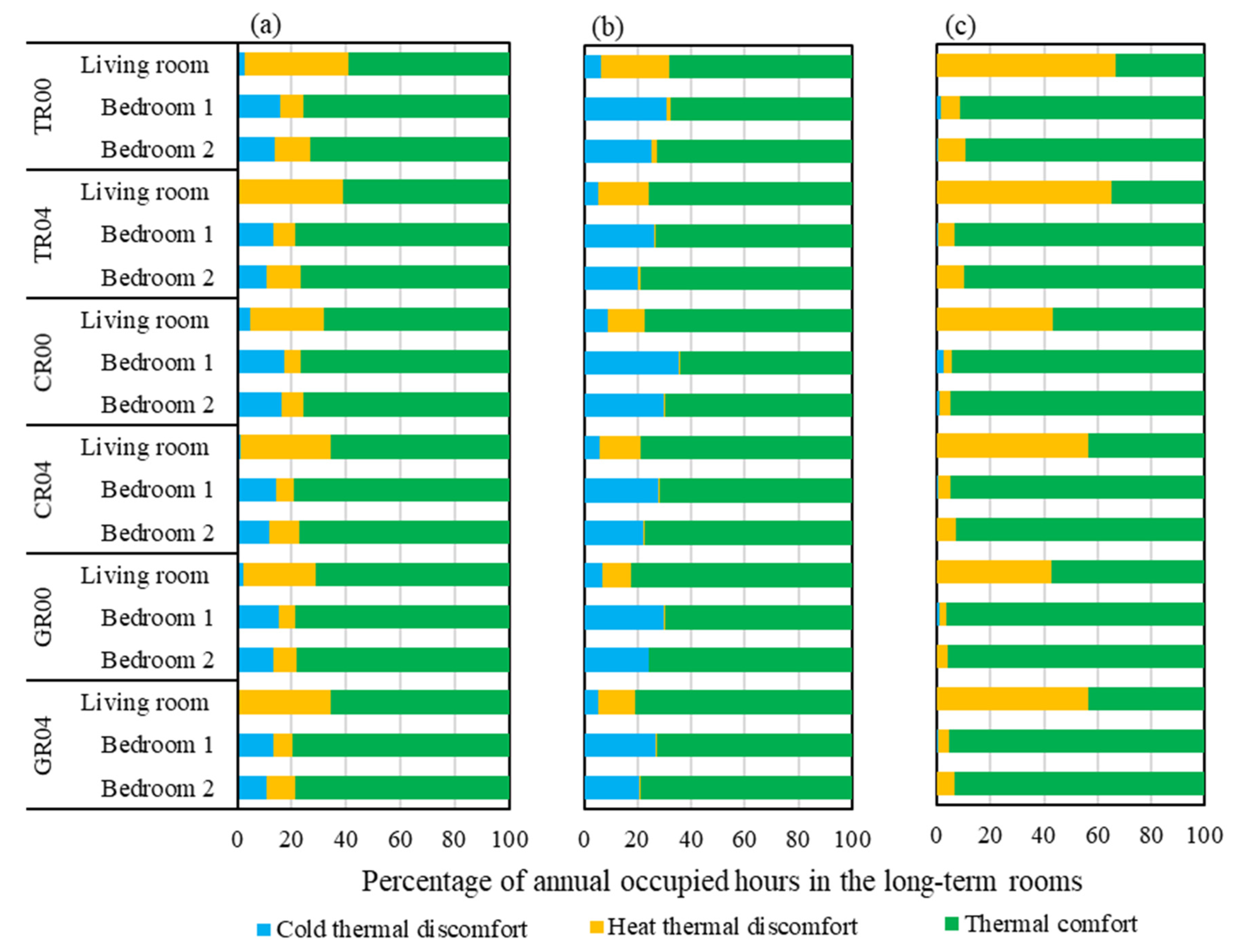


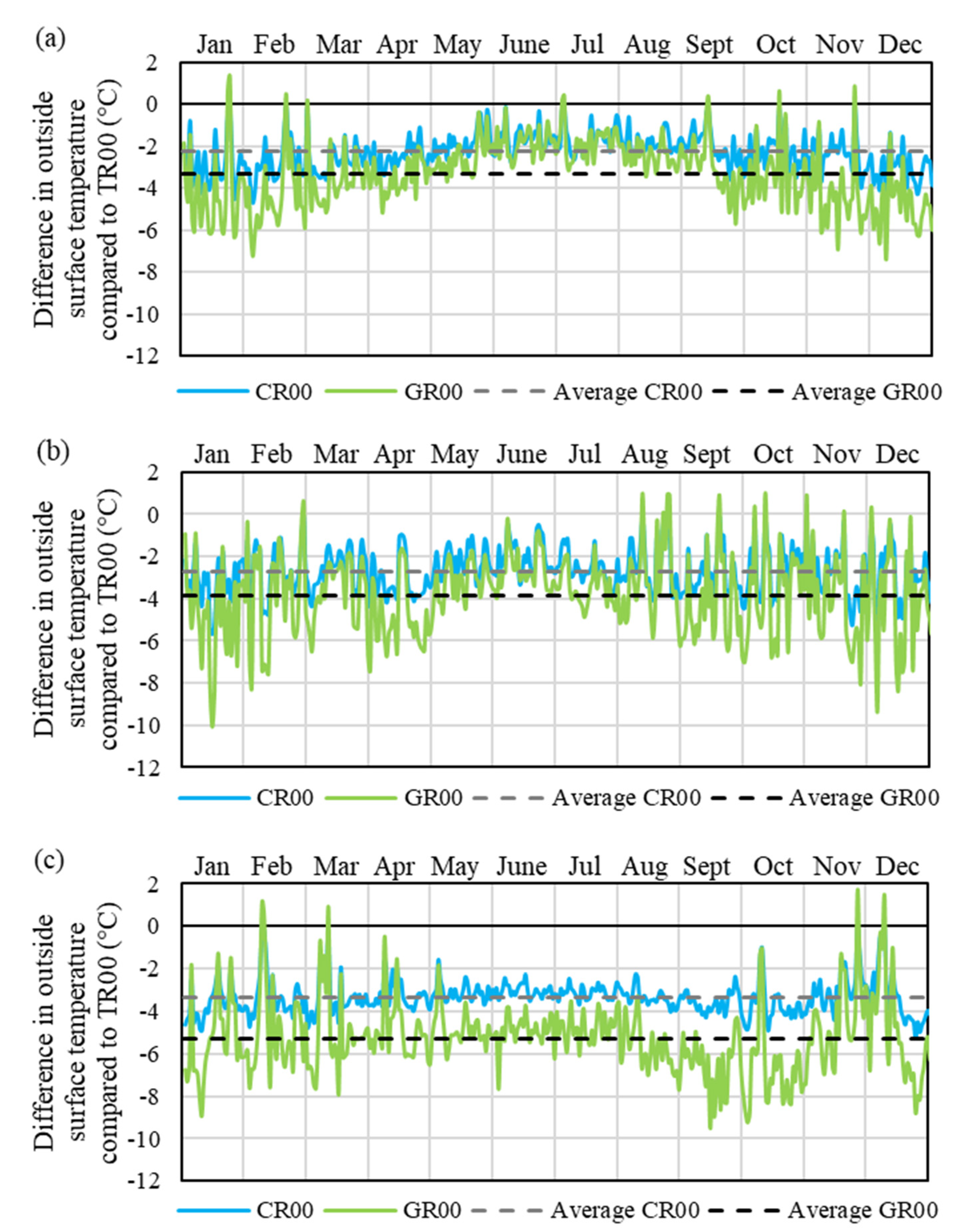
| Parameter | Roof Typology | City | ||
|---|---|---|---|---|
| Florianópolis | Curitiba | Brasília | ||
| Heating and cooling energy in long-term rooms (kWh/m2.year) | TR00 | 15.0 | 9.1 | 18.1 |
| TR04 | 15.0 | 8.1 | 18.2 | |
| CR00 | 12.5 | 7.0 | 13.6 | |
| CR04 | 14.0 | 7.2 | 16.4 | |
| GR00 | 12.8 | 6.5 | 14.3 | |
| GR04 | 14.1 | 7.1 | 16.6 | |
| Thermal comfort (average percentage of annual thermal comfort hours in long-term rooms) | TR00 | 69.4 | 69.5 | 71.3 |
| TR04 | 72.2 | 76.0 | 72.8 | |
| CR00 | 73.5 | 70.2 | 82.0 | |
| CR04 | 74.1 | 76.1 | 77.2 | |
| GR00 | 76.0 | 75.9 | 83.3 | |
| GR04 | 74.7 | 77.6 | 77.5 | |
| Peak temperature (hourly) of the outside roof surface (°C) | TR00 | 62.8 | 65.5 | 61.9 |
| TR04 | 68.3 | 72.7 | 68.4 | |
| CR00 | 49.1 | 49.9 | 47.8 | |
| CR04 | 52.9 | 54.8 | 52.6 | |
| GR00 | 41.4 | 39.1 | 40.5 | |
| GR04 | 41.2 | 38.8 | 40.7 | |
Disclaimer/Publisher’s Note: The statements, opinions and data contained in all publications are solely those of the individual author(s) and contributor(s) and not of MDPI and/or the editor(s). MDPI and/or the editor(s) disclaim responsibility for any injury to people or property resulting from any ideas, methods, instructions or products referred to in the content. |
© 2024 by the authors. Licensee MDPI, Basel, Switzerland. This article is an open access article distributed under the terms and conditions of the Creative Commons Attribution (CC BY) license (https://creativecommons.org/licenses/by/4.0/).
Share and Cite
Scolaro, T.P.; Ghisi, E.; Silva, C.M. Effectiveness of Cool and Green Roofs Inside and Outside Buildings in the Brazilian Context. Sustainability 2024, 16, 8104. https://doi.org/10.3390/su16188104
Scolaro TP, Ghisi E, Silva CM. Effectiveness of Cool and Green Roofs Inside and Outside Buildings in the Brazilian Context. Sustainability. 2024; 16(18):8104. https://doi.org/10.3390/su16188104
Chicago/Turabian StyleScolaro, Taylana Piccinini, Enedir Ghisi, and Cristina Matos Silva. 2024. "Effectiveness of Cool and Green Roofs Inside and Outside Buildings in the Brazilian Context" Sustainability 16, no. 18: 8104. https://doi.org/10.3390/su16188104
APA StyleScolaro, T. P., Ghisi, E., & Silva, C. M. (2024). Effectiveness of Cool and Green Roofs Inside and Outside Buildings in the Brazilian Context. Sustainability, 16(18), 8104. https://doi.org/10.3390/su16188104











